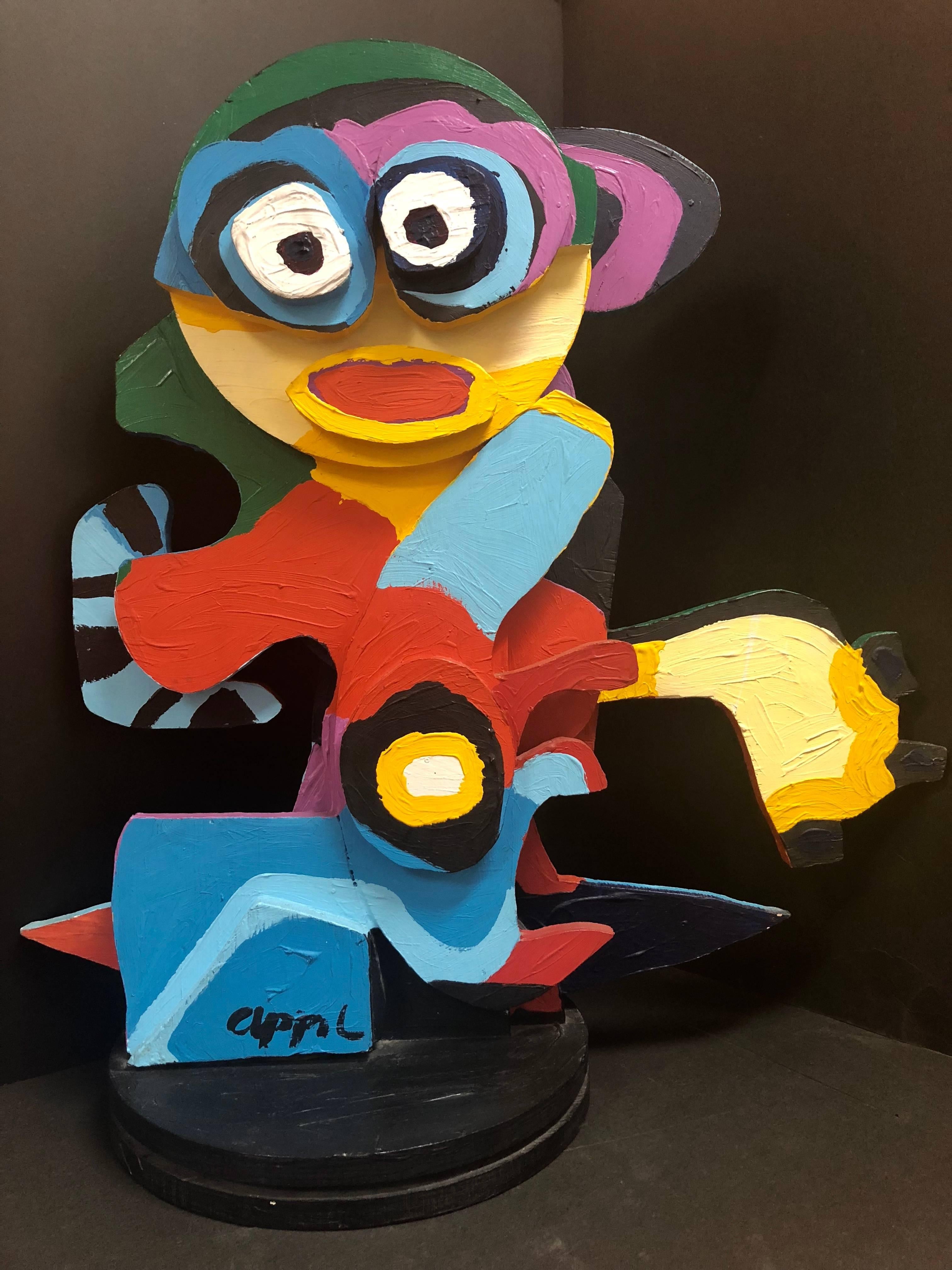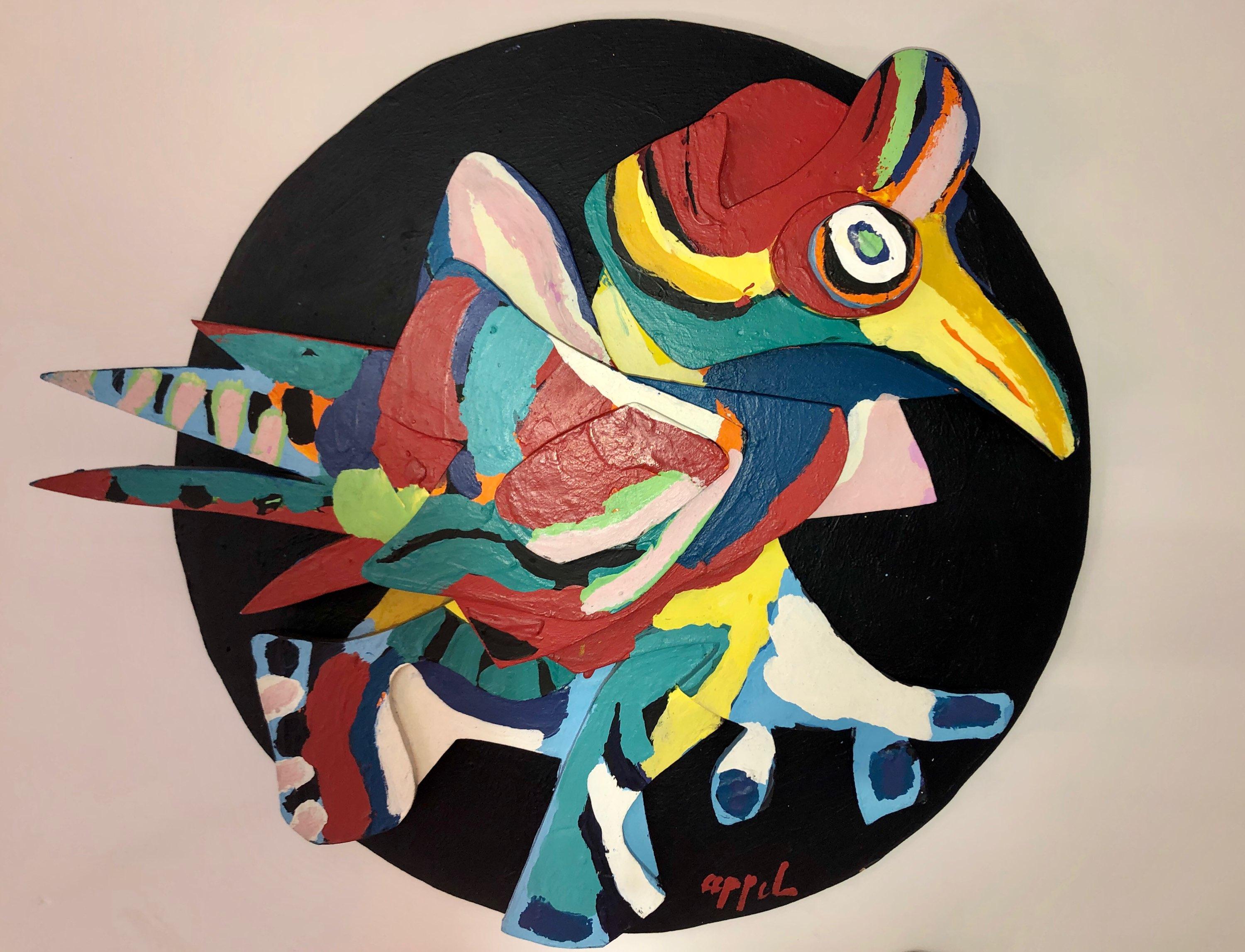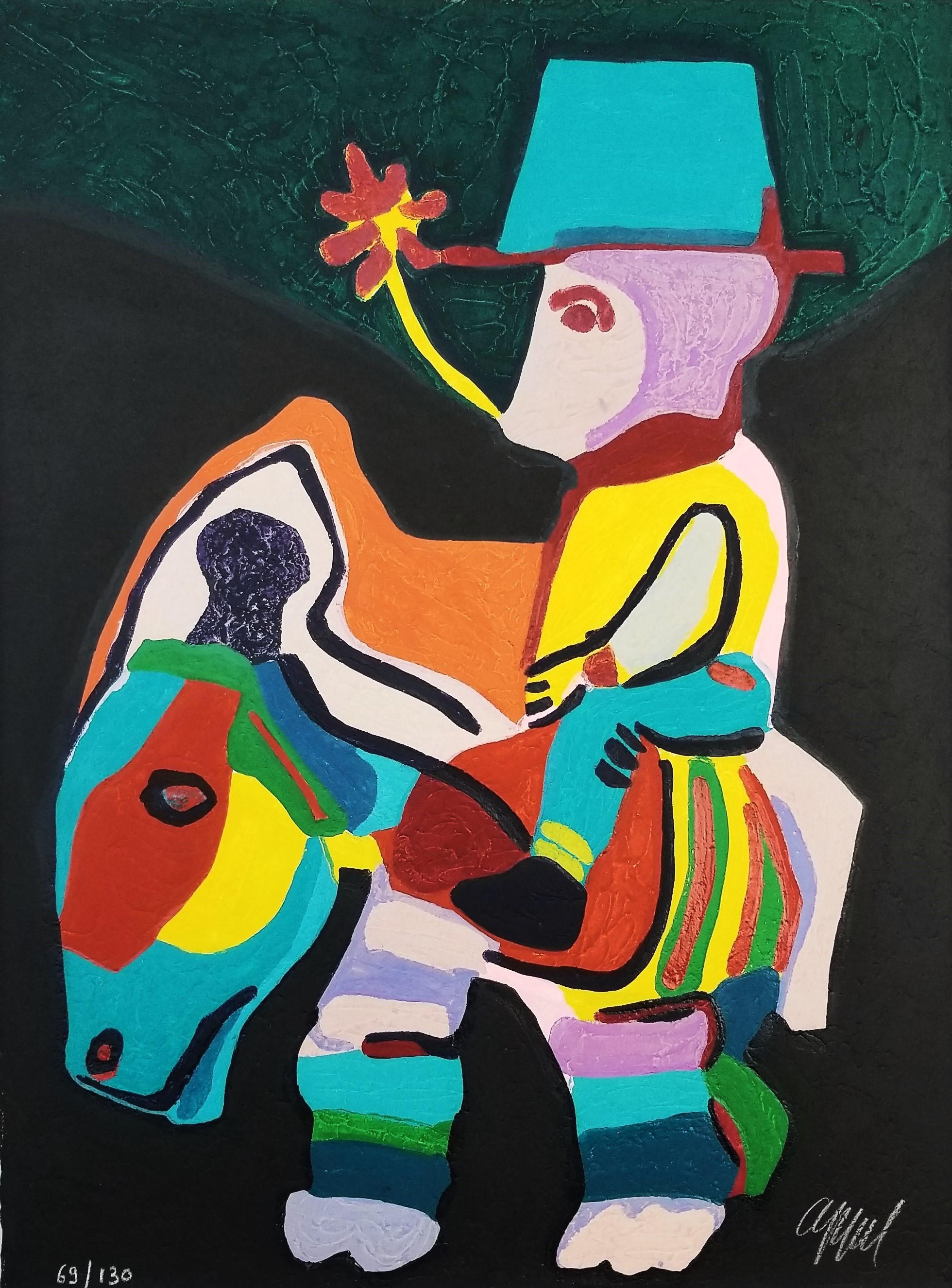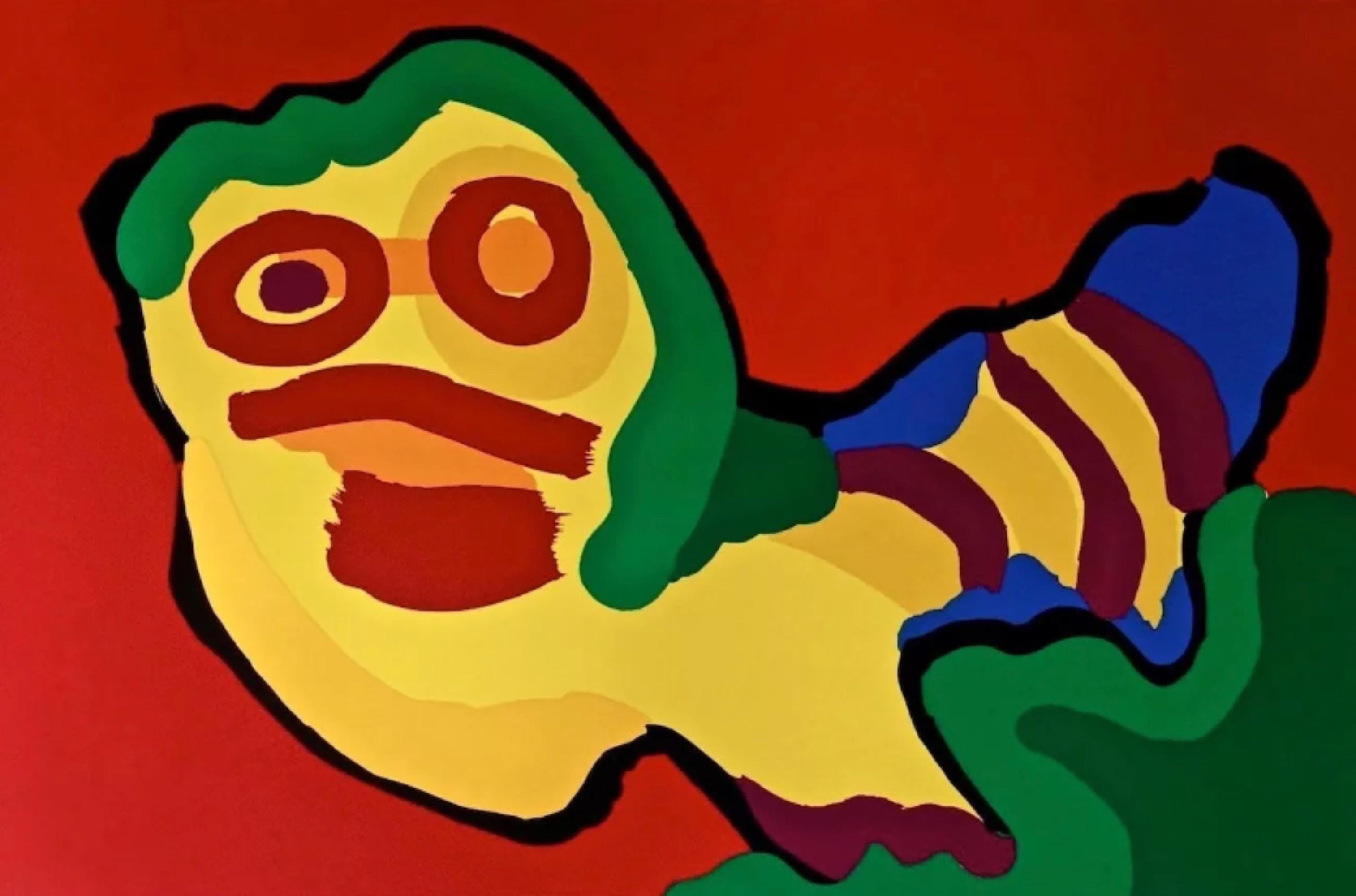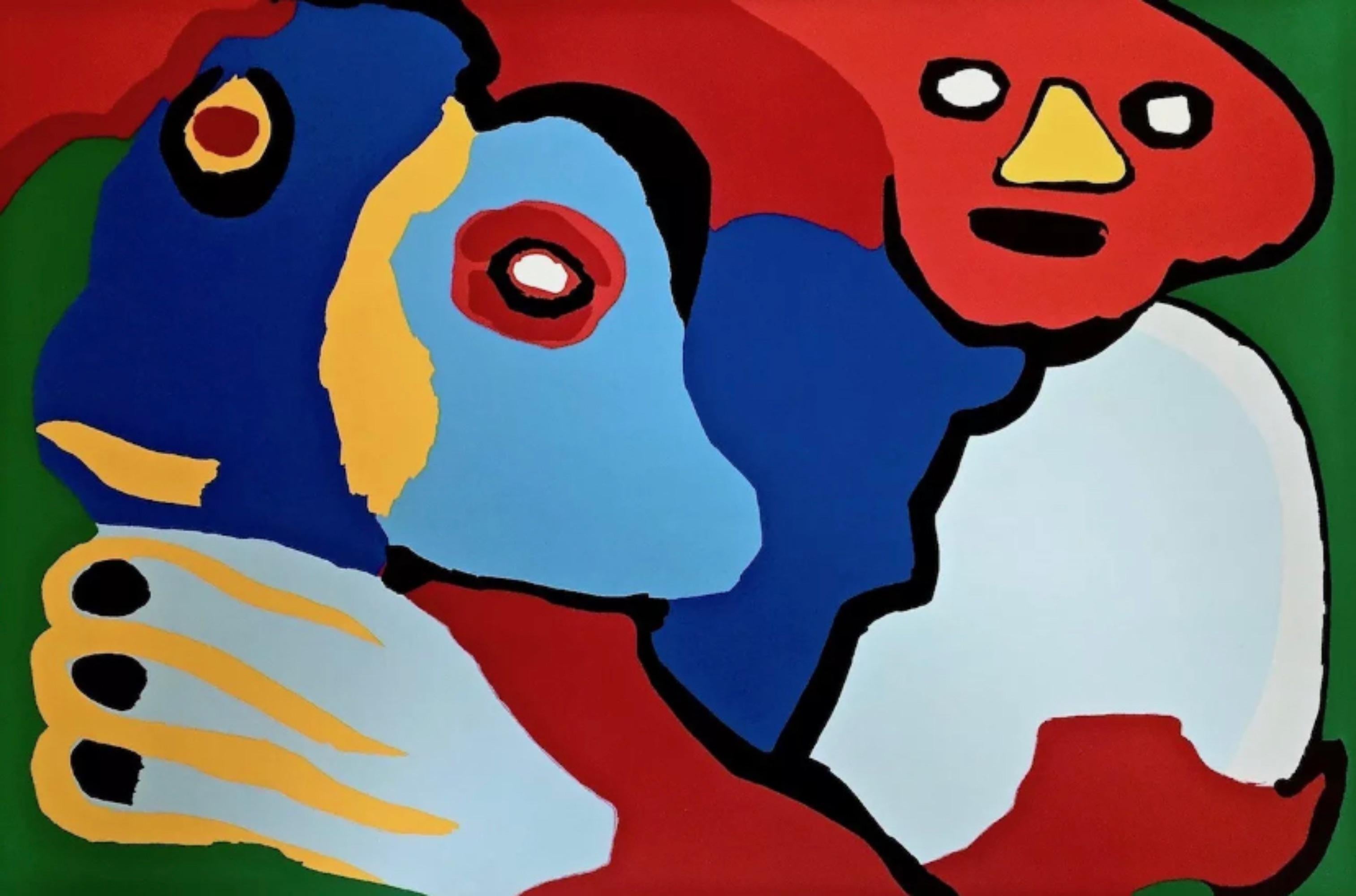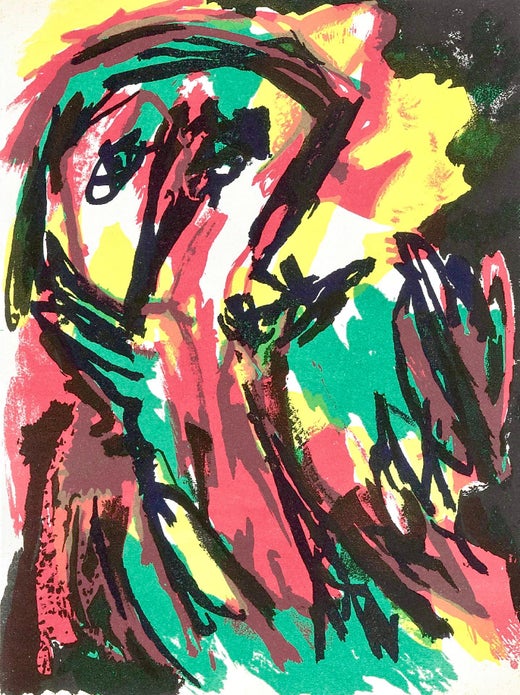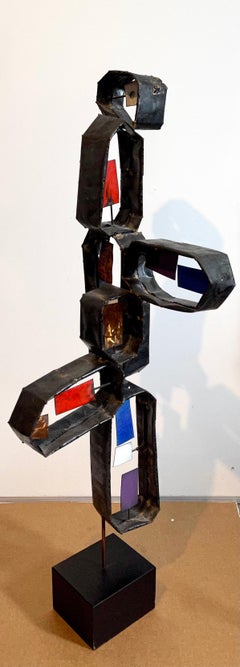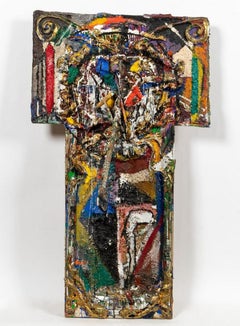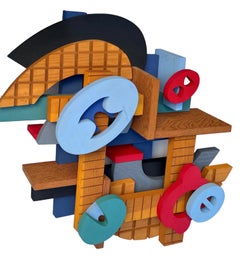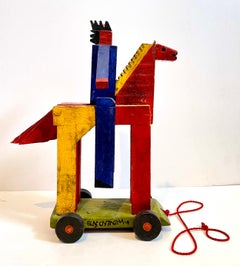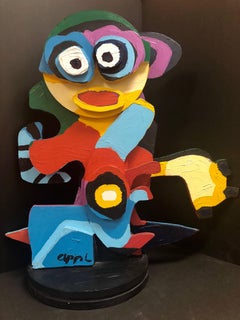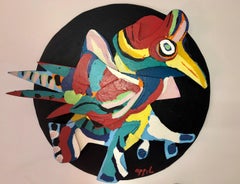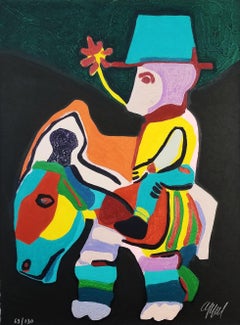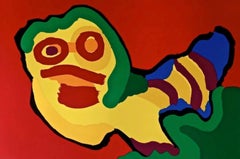Items Similar to Karel Appel Colorful Expressionist Hand Painted Wood Cobra Sculpture Pop Art
Want more images or videos?
Request additional images or videos from the seller
1 of 9
Karel AppelKarel Appel Colorful Expressionist Hand Painted Wood Cobra Sculpture Pop Art1977
1977
$22,000
£16,364.28
€19,159.34
CA$30,697.47
A$34,351.33
CHF 17,936.65
MX$422,313.87
NOK 226,291.53
SEK 212,939.22
DKK 142,943.36
Shipping
Retrieving quote...The 1stDibs Promise:
Authenticity Guarantee,
Money-Back Guarantee,
24-Hour Cancellation
About the Item
This is an original wooden sculpture with hand painting on both sides. it does not appear to be signed or numbered and does not currently have any label. I believe this might be the proof, There was an edition of these and this is a unique variant. All done by hand.
It is on a base and revolves and rotates easily as there are ball bearings. It is very well made.
Christiaan Karel Appel (1921-2006) was a Dutch artist, painter, sculptor, and poet. Born in Amsterdam, the Netherlands, he died in Zurich, Switzerland. He started painting at the age of fourteen and studied at the Rijksakademie in Amsterdam in the 1940s. He was one of the founders of the avant-garde movement Cobra in 1948. He was also an avid sculptor and has had works featured in MoMA, the Stedelijk and other museums worldwide.
At fourteen, Appel produced his first real painting on canvas, a still life of a fruit basket. For his fifteenth birthday, his wealthy uncle Karel Chevalier gave him a paint set and an easel. An avid amateur painter himself, Chevalier gave his namesake some lessons in painting.
From 1940 to 1943, during the German occupation, Appel studied at the Rijksakademie van Beeldende Kunsten in Amsterdam, and it was there he met the young painter Guillaume Corneille and, some years later, Constant; they became close friends for years.
Appel had his first show in Groningen in 1946. In 1949 he participated with the other CoBrA artists in the Stedelijk Museum Amsterdam; this generated a huge scandal and many objections in the press and public. He was influenced by Pablo Picasso, Henri Matisse, and the French brute-art artist Jean Dubuffet. In 1947 he started sculpting with all kinds of used materials (in the technique of assemblage) and painted them in bright colors: white, red, yellow, blue, and black. He joined the Experimentele Groep in Holland together with the young Dutch painters Anton Rooskens, Theo Wolvecamp, and Jan Nieuwenhuys. Later the Belgian writer Hugo Claus joined the group.
In 1948 Appel joined CoBrA (from Copenhagen, Brussels, Amsterdam) together with the Dutch artists Corneille, Pierre Alechinsky, Ernest Mancoba, Constant, Asger Jorn and Jan Nieuwenhuys (see also Aart Kemink), and with the Belgian poet Christian Dotremont. Their working method was based on spontaneity and experiment, and they drew their inspiration in particular from children’s drawings, Graffiti, ancient art forms and from the Surrealist work of Paul Klee and Joan Miro. Cobra was a milestone in the development of Tachisme and European abstract expressionism. The new art of the CoBrA group was not popular in the Netherlands, but it found a warm and broad welcome in Denmark. By 1939, Danish artists had already started to make spontaneous art and one of their sources of inspiration was Danish and Nordic mythology. Appel moved to Paris in 1950 and developed his international reputation by travelling to Mexico, the USA, Yugoslavia, and Brazil. He also lived in New York City and Florence. His first American gallery exhibition took place in 1954 at the Martha Jackson Gallery. The following year his painting Child and Beast II (1951) was included in the influential exhibition, The New Decade at the Museum of Modern Art which featured the work of twenty-two European painters and sculptors including newcomers like Francis Bacon, Jean Dubuffet, and Pierre Soulages. He is particularly noted for his mural work. After 1990 he became much more popular in the Netherlands; he had several big shows in Amsterdam and Brussels, organized by director Rudy Fuchs. Also, the CoBrA-museum in Amstelveen organized several shows featuring his work. He became the most famous Dutch CoBrA artist.
Appel's work has been exhibited in a number of galleries, including the Anita Shapolsky Gallery in New York City, Galerie Lelong in Paris, Galerie Ulysses in Vienna, and Gallery LL in Amsterdam.
Appel died on 3 May 2006 in his home in Zürich, Switzerland. He suffered from a heart ailment. He was buried on 16 May 2006 at the Père Lachaise Cemetery in Paris, France.
Public collections
Museum de Fundatie, Zwolle, The Netherlands
Rijksmuseum, The Netherlands
The Phillips Collection, Washington DC, USA
Museum of Fine Arts, Boston MA
Albright-Knox Art Gallery, Buffalo U
The Museum of Modern Art, New York
Solomon R. Guggenheim Museum
San Francisco Museum of Modern Art
Hirshhorn Museum and Sculpture Garden
Tate Modern, London
Centraal Museum, Utrecht
Cobra Museum voor Moderne Kunst
Stedelijk Museum Amsterdam
Moderna Museet, Stockholm
Museo Thyssen-Bornemisza Madrid
IVAM, Centre Julio González Valencia Spain
Museo de Bellas Artes de Bilbao, Spain
Museo de Arte Moderno, Mexico City
National Museum of Art Osaka, Japan
Collezione Peggy Guggenheim, Venice
Tel Aviv Museum of Art Tel Aviv, Israel
Museum Ludwig
- Creator:Karel Appel (1921 - 2006, Dutch)
- Creation Year:1977
- Dimensions:Height: 30.5 in (77.47 cm)Width: 28 in (71.12 cm)Depth: 14 in (35.56 cm)
- Medium:
- Movement & Style:
- Period:
- Condition:good. minor wear.
- Gallery Location:Surfside, FL
- Reference Number:1stDibs: LU38215400442
Karel Appel
Karel Appel was a founding member of COBRA, an art movement originating in Germany that strived to replicate and invoke the child’s approach to art. Within this movement he created abstracted and simplified figures, often monsters and fractured depictions of people.
About the Seller
4.9
Platinum Seller
Premium sellers with a 4.7+ rating and 24-hour response times
Established in 1995
1stDibs seller since 2014
1,777 sales on 1stDibs
Typical response time: 1 hour
- ShippingRetrieving quote...Shipping from: Surfside, FL
- Return Policy
Authenticity Guarantee
In the unlikely event there’s an issue with an item’s authenticity, contact us within 1 year for a full refund. DetailsMoney-Back Guarantee
If your item is not as described, is damaged in transit, or does not arrive, contact us within 7 days for a full refund. Details24-Hour Cancellation
You have a 24-hour grace period in which to reconsider your purchase, with no questions asked.Vetted Professional Sellers
Our world-class sellers must adhere to strict standards for service and quality, maintaining the integrity of our listings.Price-Match Guarantee
If you find that a seller listed the same item for a lower price elsewhere, we’ll match it.Trusted Global Delivery
Our best-in-class carrier network provides specialized shipping options worldwide, including custom delivery.More From This Seller
View AllItalian Mid Century Mod Large Brutalist Welded Copper Enamel Sculpture Wood Base
Located in Surfside, FL
Welded, brazed, copper (based on the weight, this might be iron or bronze) with colorful inset enamel plaques on a painted wood base. A studio handmade Brutalist sculpture in a mann...
Category
Mid-20th Century Abstract Abstract Sculptures
Materials
Metal, Copper, Enamel
Mixed Media Neo Expressionist Collage Assemblage Painting Sculpture Art Brut
By Loren Munk
Located in Surfside, FL
LOREN MUNK
(american b. 1951)
MUNKEY BUSINESS
Signed and dated 'Munk 84' verso, mixed media construction with paint brushes, mirrored mosaic tile, gold leaf and oil paint
57 x 33 x 23 in. (144.8 x 83.8 x 58.4cm)
Provenance: Malcolm Forbes collection
The artist Loren Munk (born 1951) is primarily known for his YouTube nickname James Kalm as an uploader of videos about New York exhibitions, amongst others. He presents himself as a maker of contemporary paintings for several decades and of cubist paintings of urban imagery. Munk has received accolades for his drawings and mosaics. He differs from traditional mosaic artists by the manner in which he incorporates glass into his decorative paintings. His unique and innovative use of materials such as mirror, gold-leaf and glass mosaic affirmed him as a founding force of Kitsch Art and a leading member of New York Neo-Expressionism.
Munk's work debuted in SoHo in 1981 with a double show at J. Fields Gallery and Gabrielle Bryers. Since then, he has overseen an international career. In addition to exhibiting in Brazil, France, Germany and the United States, Munk has received national and overseas, public and private commissions. He is well represented in important collections throughout Europe, South and North America and the Middle East.
Most recently, Munk has been producing a series of paintings which tackle the subject of art itself through a historical and diagrammatic lens. Munk documents the New York art world in YouTube videos, using the name James Kalm.
Timeline:
1979 Attended Art Students League, New York
1973-75 Attended University of Maryland at Ramstein, Germany while in US Army
1969-72 Attended Idaho State University, Pocatello, Idaho
1951 Born, Salt Lake City, Utah
Select Group Exhibitions
2018 “Under Erasure” curated by Heather and Raphael Rubinstein at Pierogi Gallery New York
2016 "It Was Never Linear: Recent Painting" at the Sheldon Museum of Art Lincoln Neb. with: Robert Bordo, Dawn Clements...
Category
1980s Neo-Expressionist Mixed Media
Materials
Gold Leaf
Large Abstract Wood Sculpture Colorful Wooden Painting John Okulick Wall Hanging
By John Okulick
Located in Surfside, FL
John Okulick, large colorful wood wall sculpture construction
"Perfect Harmony"
Hand signed and dated, 1999
Dimensions: H: 52 inches:...
Category
1990s Contemporary Abstract Paintings
Materials
Metal
Blas Castagna Hand Painted Wooden Constructivist Sculpture Toy Horse Carved Wood
Located in Surfside, FL
Blas Alfredo Castagna was born in Buenos Aires, Argentina in 1935. He studied at the Manuel Belgrano National School of Fine Arts and at the Prilidiano Pueyrredón School, where he obtained the title of National Professor of Drawing and Decorator Painter. In 1959 he traveled to Italy and in Sicily he attended the metal-beating workshop at the Scuola d´Arte di Comiso. A year later, he had a solo show of oil painting and gouaches at the “Alcora” Gallery in Buenos Aires, also presenting it in the province of San Juan. In addition to his artistic activity, he worked between 1974 and 1976 as a teacher in the Department of Plastic Arts, Faculty of Humanities, of the National University of San Juan. In 1982 he was invited to exhibit plates and monotypes at the Galerie de L´Université - Tour Mauran in Toulouse, France. A year later he exhibited in our country at the Van Riel Gallery, where a long connection with this room begins. In 1998 he exhibited again in Toulouse, at the Espace Croix Baragnon, an exhibition entitled "Origins, Mémoide", also presenting that year, at the Enrique Larreta Museum of Spanish Art in Buenos Aires, his "Obra Figurativa 1973-1993". Collectively, he presents his works in Uruguay, Cuba, Spain, at the Museum of Modern Art in Buenos Aires and at the National Museum of Fine Arts, at the Borges Cultural Center (2007 and 2008), at the Museum of Modern Art in Bahia ( Brazil, 2005), at the Sainsbury Center Norwich (United Kingdom, 2004), Centro Cultural Recoleta (1999), at the Fortabat Foundation (1985), at the II Biennial of Havana (1986) and at the ARCO fair in Madrid ( 1987). In 1990 he was awarded the Spirit of Greece Award for engraving, and in 1992 the “Konex Platinum Award. His work is influenced by the Latin American geometric constructivism present in Argentina and Uruguay as well as the European influences of Surrealism and Dada Art.
He showed at the prestigious van Riel Gallery. For over 80 years the Frans van Riel Gallery has exhibited at the forefront of Argentinean art. Beginning with Alfredo Hlito “Grupo de Artistas Modernos de la Argentina” (Argentinian Modern Artists). The avant-garde of the 1950s and the work of Kenneth Kemble, Leónidas Gambartes and the Grupo Litoral, Juan Del Prete, Aldo Paparella sculpture, Julio Llinás, Aldo Pellegrini, Juan Batlle Planas, Libero Badii, Malena Babino, Horacio Butler, Alejandro Corujeira, Juan Del Prete, Kirin, Luis Felipe Noé...
Category
20th Century Neo-Constructivist Figurative Sculptures
Materials
Fabric, Wood, Paint
Mixed Media Sculptural Painting "Juggler" Modernist
By Alexander Raymond Katz
Located in Surfside, FL
Genre: Modern
Subject: Abstract
Medium: Mixed Media
Surface: Board
Dimensions: 15 1/2" x 19 1/2"
Reminiscent of the Art Brut work of french master Jean Dubuffet this Boy with balls is a wonderful mixed media piece with stypol, copper resin, concrete all in a great colorful composition.
Alexander Raymond Katz, Hungarian / American (1895 – 1974)
Alexander Raymond Katz was born in Kassa, Hungary, and came to the United States in 1909. He studied at the Art Institute of Chicago and the Chicago Academy of Fine Arts. In the late 1920s, he worked as a director of the Poster Department at Paramount Studios. He was appointed the Director of Posters for the Chicago Civic Opera in 1930.
During the Great Depression, notable architect Frank Lloyd Wright urged Katz to become a muralist. In 1933, he was commissioned to paint a mural for the Century of Progress exposition in Chicago. In 1936, he painted the mural History of the Immigrant for the Madison, Ill., post office. Katz’s works were included in various exhibitions and now are part of several museum collections, including those of the Art Institute of Chicago; Corcoran Gallery of Art, Washington, D.C.; and the Jewish Museum, New York. His murals, bas-reliefs and stained glass designs adorn more than 200 Jewish synagogues...
Category
Mid-20th Century Modern Mixed Media
Materials
Mixed Media
Large Color French Cubist Lithograph Tree of Life Signed Ltd Ed. Sculpture Study
By Jacques Lipchitz
Located in Surfside, FL
Chaim Jacob Lipchitz, 1891-1973, was born in Lithuania and came of age in Paris during the early 20th century, where he was active in the avante-garde community of Pablo Picasso, Ama...
Category
1970s Cubist Figurative Prints
Materials
Lithograph
You May Also Like
Karel Appel, Close Together, original hand painted wood sculpture
By Karel Appel
Located in Chatsworth, CA
This piece is an original rotating hand-painted multiple wood sculpture created by Karel Appel in 1977. It was published by Editions Press of San Francisco. This piece is hand sign...
Category
1970s Modern Figurative Sculptures
Materials
Wood, Paint
L'Oiseaux
By Karel Appel
Located in New York, NY
Karel Appel
L'Oiseau, 1977
Hand-Signed
Unique
Wood sculpture (Polychrome over wood)
Diameter 34"
Category
Late 20th Century Abstract Sculptures
Materials
Wood
Price Upon Request
L'Âne Trop Paisible Pour Les Enfants Cruels /// Karel Appel Color Woodcut COBRA
By Karel Appel
Located in Saint Augustine, FL
Artist: Karel Appel (Dutch, 1921-2006)
Title: "L'Âne Trop Paisible Pour Les Enfants Cruels (A Donkey Too Gentle for the Cruel Children)" (Plate 19)
Portfolio: Circus (Volume II)
*Si...
Category
1970s Abstract Expressionist Figurative Prints
Materials
Engraving, Woodcut
Nothing to Do, Karel Appel
By Karel Appel
Located in Fairfield, CT
Artist: Karel Appel (1921-2006)
Title: Nothing to Do
Year: 1974
Medium: Silkscreen on Somerset paper
Edition: H.C.;110, plus proofs
Size: 27 x 39.25 inches
Condition: Good
Inscriptio...
Category
1970s Abstract Expressionist Abstract Prints
Materials
Screen
$3,400 Sale Price
20% Off
Clown Cat - Limited Edition Sculpture 9/10
By Karel Appel
Located in AMSTERDAM, NL
Discover the Essence of Joy: Karel Appel's "Clown Cat" 9/10 Limited Edition Sculpture in Acrylic on wood.
Crafted from the finest wood, its playful contours and vibrant hues captiva...
Category
1970s Abstract Expressionist Abstract Sculptures
Materials
Wood, Acrylic
Moving the Wind, Karel Appel
By Karel Appel
Located in Fairfield, CT
Artist: Karel Appel (1921-2006)
Title: Moving the Wind
Year: 1974
Medium: Silkscreen on Somerset paper
Edition: 88/110, plus proofs
Size: 27 x 39.25 inches
Condition: Good
Inscriptio...
Category
1970s Pop Art Abstract Prints
Materials
Screen
$3,400 Sale Price
20% Off
More Ways To Browse
Vintage Hand Sculpture
Signed Wood Sculpture
Mexican Wood Sculpture
German Wood Sculpture
Fruit Sculpture
Danish Wood Sculpture
Christian Dior Made In Usa
Christian Of Copenhagen
Christian Dior 2006
Christian Dior 1947
Christian Dior 1940
Ball Bearings
Vintage Wooden Fruit Basket
Vintage Wooden Fruit Baskets
Pierre Lelong
Vintage Ball Bearings
